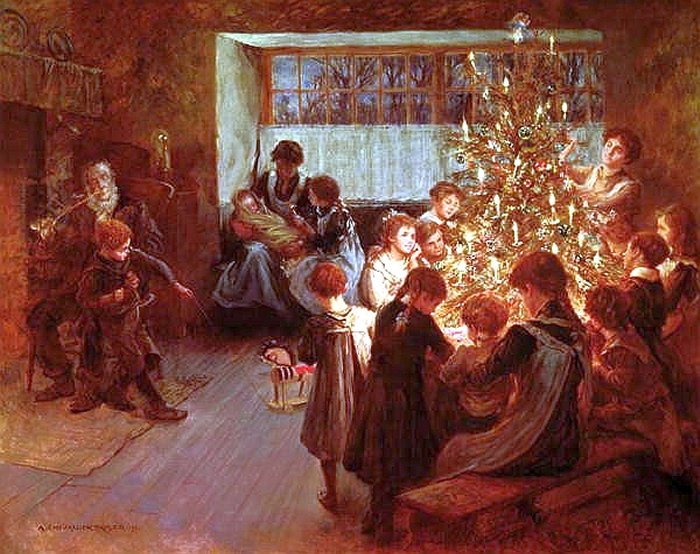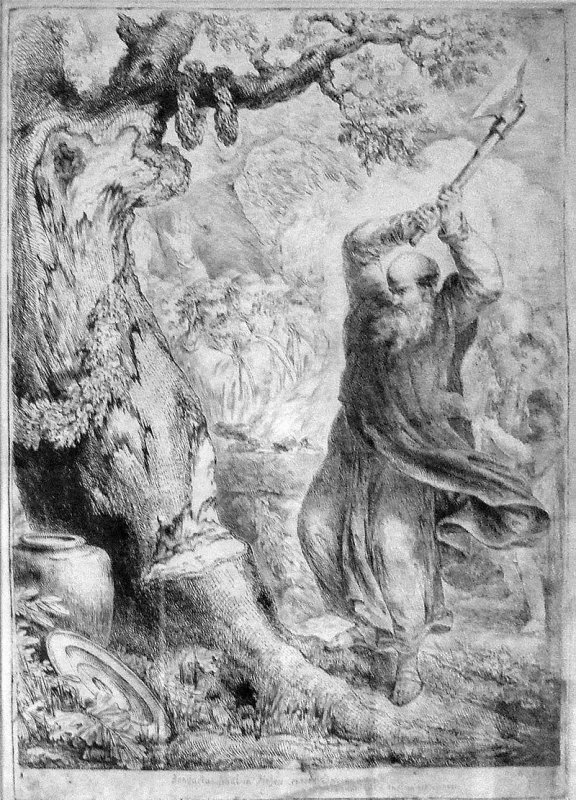Ellen Lloyd – AncientPages.com – It isn’t easy to imagine a Christmas celebration without a beautifully decorated Christmas tree at home. In the United States alone, more than 40 million real or specially grown trees are sold during the Christmas period each year.

You can find a Christmas tree in most Christan homes. Credit: Vladislav FotOf – Adobe Stock
Now, picture the number of sold trees worldwide. Almost everyone who celebrates Christmas wants a Christmas tree. Whether it’s a real one or an artificial one, the tree is simply an appreciated tradition and part of our holidays. Nowadays, you can buy Christmas trees in all sizes and colors, but how, when, and where did the Christmas tree tradition start?
We take the Christmas tree for granted, but did you know this was once a forbidden tree people were not allowed to have at home? It’s incredible how the Christmas tree survived against all odds.
As with many other Christian traditions, we find the answer to our question by examining Pagan festivals celebrated by our ancestors.
Trees Have Been Worshipped Since Ancient Ancient Times
Many ancient cultures worshipped trees, which have become a symbol of life. In Norse mythology, the Yggdrasil is an eternal and sacred Ash tree with branches that stretch out to harbor nine worlds. It has three roots, and each one reaches a different mysterious world.
Ancient Celts held nature and animals in high regard, and their Celtic Tree of Life was a portal to invisible worlds and a source of sacred knowledge guarded by the most enlightened ones.
In ancient India, we came across the Kalpa Tree’ Kalpavriksha’. This sacred wishing tree has long been an object of adornment and worship. It was believed that this tree produced the fruit which nourished the first men.

The Christmas Tree 1911 by Albert Chevallier Tayler. Credit: Public Domain
Among Native American tribes, Cedar is considered the most sacred tree. According to the Navajo (Dineh), it was the first tree planted by man in the Third World to save people from a flood, according to the Navajo (Dineh). Turning our attention to Mesoamerica, we learn that the Mixtec, Aztec, Maya, and other cultures considered the Ceiba tree sacred.
There are most likely some exceptions, but in ancient and modern times, trees played an important role in traditional cultures around the world. In many mythologies, the tree is represented as the source of life, the center of the universe, and the cosmic tree.
To Christians today, the Christmas tree is of particular importance, but the green tree we decorated shortly before Christmas has Pagan roots, and there was a time when the Church did not accept it.
Everything started when people decided they wanted to have green plants inside. It didn’t matter what kind of tree it was as long as it was green. According to folklore beliefs, green plants and trees protected people from various evil forces, such as malevolent spirits. It also explains why mistletoe was so sacred. During winter, when the days are dark and cold, green plants and trees remind us that the Sun will return, and we may embrace warmer days eventually. Vikings believed spirits known as vættir (vättar in Swedish) lived in trees. They didn’t want these tiny creatures to freeze during winter, so they took the trees inside, letting the spirits enjoy a warm and cozy atmosphere at home.
Story Of The First Christmas Tree
Legend has it that the first Christmas tree can be traced to Saint Boniface, an eighth-century English missionary to the Pagan tribes in the land that became Germany. When the saint learned in 723 A.D. that people worshipped a Donar Oak (Thunder Oak) dedicated to the Norse god Thor, he chopped it off. It sounds like a horrible thing to do, but St. Boniface argued Thor was not a real god.

Saint Boniface felling Donar’s Oak. Engraving by Bernhard Rode, 1781. Credit: Bernhard Rode
If Thor were a real God, he would have killed Boniface, but that didn’t happen. St. Boniface told everyone that his survival was proof his God was the mightier one, and no one wanted to argue with him after this incident. According to this legend, St. Boniface planted a fir tree instead of the oak, which became the first Christmas tree.
How much of this legend is true is difficult to say, but we know the first recorded use of a Christmas tree in an Estonian monastery in 1441.
Why The Christmas Tree Was Not Accepted By The Church Until 1640
The Church has long been reluctant to accept the tree because of its Pagan origins. The tree protected against trolls, witches, and several supernatural creatures. Christian leaders couldn’t see how the green tree could be incorporated into the Christmas tradition. For a long time, Christmas trees were forbidden in many countries, at least until 1640.
In Russia, a Christmas tree was not allowed between 1917 and 1992, but people didn’t want to give up on the tree, and instead of calling it a Christmas Tree, they referred to it as the New Year Tree.
Once the tree became a part of the Christmas celebrations in northern Germany, the tradition spread to other European countries. Instead of decorating a tree in the woods, people placed smaller trees indoors. Queen Victoria introduced the practice in the United Kingdom, where the tree became very popular. Soon, all Christians in many European countries wanted a Christmas tree, but only rich people could afford it. Fortunately, this changed in time, and every believer could afford a Christmas tree, even if it sometimes were just a smaller one.
In the United States, German immigrants most likely introduced the Christmas tree tradition.
See also: More About Christmas Traditions.
So, why not end this article simply by saying – that when you decorate your Christmas tree this year, don’t take it for granted. Remember its ancient history and thank your ancestors that the Christmas tree survived against all odds despite being forbidden for a long time. Some traditions are here to stay.
Updated on December 11, 2023
Written by Ellen Lloyd – AncientPages.com
Copyright © AncientPages.com All rights reserved. This material may not be published, broadcast, rewritten or redistributed in whole or part without the express written permission of AncientPages.com
Expand for references
Line Therkelsen – Magisk Jul – traditioner, myter, och övertro från Vikingatid till idag, 2018
McLaughlan David – The Top 40 Traditions of Christmas: The Story Behind the Nativity, Candy Canes, Caroling, and All Things Christmas
Ace Collins – Stories Behind the Great Traditions of Christmas





